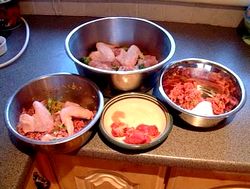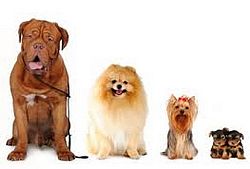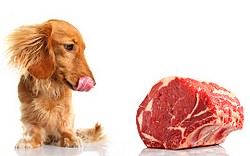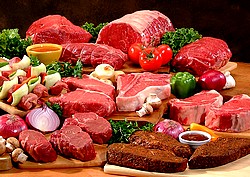Q&A: Raw Dog Food - Pros and Cons of Feeding Your Dog a Raw Diet
Raw food for dogs regularly pops in and out of the news especially when health and disease warnings are issued about either raw food or prepared foods. Raw dog food diets emphasize raw meat, bones, fruits, and vegetables in various combinations. Racing greyhounds and sled dogs have been fed raw food diets for centuries and many dog owners turn to these diets when their dogs are sick or develop allergies to prepared foods. Some have argued that raw foods are the 'natural' evolutionary diets for dogs. If these dies are good when an animal is sick, why not feed dogs raw food when they are healthy. Many have argued that raw food does not suit all dogs and that there are many health risks associated with the generally poor hygiene standards that apply for many fresh meats and prepared raw food diets. This article examines the pros and cons of raw food diets for does in a Q&A format to help you decide whether it is right for your dog.
When Did The Raw Food for Dogs Movement Start?
In Australia in 1993 by veterinarian Ian Billinghurst promoted the so called BARF diet, which stands for Biologically Appropriate Raw Food, which was essentially Bones and Raw Food (meat and vegetables). He put this diet forward in a book 'Give Your Dog a Bone', because it mirrored the supposed evolutionary diet of wild dog ancestors before the they became domesticated and modern breeds developed. The proposed diet consisted of raw meat, vegetable scraps and meaty bones. He argued in his book that grain-based commercial pet foods were 'unnatural' and could be harmful to a dogs. Now, everyone refers to these diets as 'Raw' Food. This idea spread throughout the world with many advocates and opponents.
Various types of processed raw dog food diet products have been developed, including commercial highly-processed raw food diet products that are freeze-dried or frozen. Many of these blend various combinations of vegetables, grains, and vitamins that are mixed with various types of raw meat. These prepared types are available in pet food store and supermarkets. Most pet owners make their own raw food diets using the various recipes that are available online. In the past it was estimated that 90% of dogs and cats owners in the USA fed their pets complete prepared and packages foods, rather than raw foods. However, because of the number of pet food recalls that have occurred in the last few years many pet owners are looking for alternatives. Many Owners switch to raw food diets in times of crisis, such as food scares or when their dogs have been diagnosed with allergies or are recovering from various aliments. Many owners don't switch back as their pets seem to like the raw food better and may be reluctant to go back to the dry packaged foods.
What are the Benefits of Raw Food Diets?
A typical raw dog food diet typically includes:
- Some dairy products, such as yogurt or skim milk powder
- Apples or other fruit
- Vegetables like spinach, broccoli and celery
- Raw eggs
- Organ meats such as kidneys and livers
- Bones, either ground or whole (not cooked)
- Muscle meat, often still on the bone
The major benefits of raw dog food diets put forward by advocates are:
- Smaller stools
- Higher energy levels
- Cleaner teeth
- Healthier skin
- Shinier coats
- High acceptance by the dog
What are the Disadvantages and Potential risks of Raw Food Diets?
- It can be very expensive compared with dry processed food. Feeding your dog can be as costly as feeding yourself, particularly with bigger breeds.
- Not every dog is suitable for a raw diet especially immune-compromised dogs and dogs with allergies.
- Internal injury from inadequately chewed bones.
- Nutritional balance is also a concern: Not having an adequate calcium source, for example, can leave a dog at risk for severe orthopedic problems.
- Dietary imbalances in the raw food diets
- Potential for whole bones to choke an animal, break teeth or cause an internal puncture
- An unbalanced diet that may damage the health of dogs if given for an extended period
- Threats to human and dog health from bacteria contamination in the raw meat that don't have to meet the same standards as food for human consumption.
- Many have questioned whether most dog owners have the right information to properly balance the diets and eliminate long term problems.
- Clearly the key is never to embark on a raw diet without doing adequate research.
Addressing some of these objections advocates remind people that good hygiene is vital when handling any raw meat, including chicken which has been the source if many Salmonella outbreaks. It is clear that most healthy dogs can handle bacteria such as E. coli or Salmonella. Also grinding raw meaty bones into a minced meat consistency virtually eliminates choking risks.
What the research say about Raw Food Diets?
Studies of raw pet food also have shown evidence of widespread bacterial contamination. A 2006 study of 20 commercially available raw meat diets found that about 7% contained Salmonella and 60% contained E. coli. These bacteria can be shed in feces, creating a risk of human exposure and infection. The study also sampled four dry dog foods and canned foods. E. coli was found in all of the commercially processed, cooked foods and in one brand of dry food at various times. Consequently bacterial contamination of pet food appears to be universal and not just apply to raw foods. Raw meat offered for human consumption, especially chicken can also be contaminated.
Many of the advocates of raw pet food claim that the risk of harmful bacteria is overblown. People know the risks associated with raw pet meat. They know it's not sterile, and they are very careful about washing their hands and avoiding contamination of areas used for preparing human food. Many claim that feeding a dog a raw meat diet has similar risks to that of preparing and cooking chicken for a family meal. People are generally aware that they have to clean up the bench tops, knifes and utensils and take special precautions to avoid contamination of cooked food from the uncooked chicken residues.
Conclusion: Weigh up the evidence and decide what is right for your dog.



